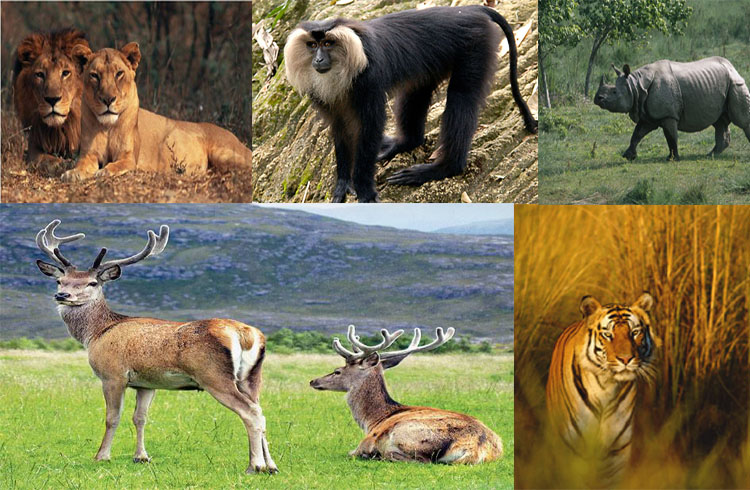Several species of plants and animals have been endangered due to human activities. The Species whose existence is in danger by human activities are called Man-wild life conflict.
Man- wild life conflicts endangered species. These endangered species have been categorized into four viz,1)Vulnerable 2) Rare 3) Intermediate 4) Threatened. Endangered species which are on verge of extinction are called threatened species. Most of the endangered species, are found today only in protected areas (PAs). Some eg of the species being Tiger, rhino, elephant; bird species include Siberian crane, great Indian bustard, Florican, vultures; reptiles and amphibians. Habitat loss caused by human activity is causing threat to plants species like orchids. Over harvesting as ingredients in medical products or cosmetics is also threatening species. To protect endangered species India has created a wildlife protection act. Under this plants and animals are characterized according to thereat to their survival. The species which are unique to a locality/region are called endemic species. Some species are found only in India and are thus endemic (restricted to our country). Some have very localized distribution and are considered highly endemic. Some species of this category being Indian wild ass, angular kashmiri stag, golden langur, pigmyhog.
Conservation of biodiversity: is of two types i.e., In situ and Ex situ
In situ conservation: Conserving a species in its own environment by creating national parks and wildlife sanctuaries. Habit is protected with all the other spp that in it in nature Biodiversity at all levels can be best preserved in situ by setting aside wildness as protected areas (in national parks and wildlife sanctuaries) with distinctive ecosystem included in the network. Such net work preserve the total diversity of life of the region.
Biologists view point is to deal with areas which are 1) Species rich 2) Rare
/threatened/endangered species / endemic species are found should be given imp as there spp would easily become extinct due to human activity. For eg. Elephants utilize open grasslands after the rains (when it is nutritious) but move into forest to feed on foliage in dry season. Hence a PA for elephant must be large to include a diverse habitat that supports a complete complement of interlinked species.
India has 589 PAs of which 89 are national parks and 500 are wildlife sanctuaries. Over 100 PAs are created in Andaman and Nicobar to preserve the special island ecosystem. The great Himalayan national park is the largest sanctuaries in the ecosystem and is the home of snow leopard. Dachigam sanctuary for hangul or kashmiri stag; Kaziranga national park for animals like elephant, guar, wild boar and swamp deer, and birds like ducks geese, pelicans and storks; Manas sanctuary for golden langur, pigmy hog and wild boar are some of the examples worth mentioning under in situ conservation.
Ex situ conservation: Conserving the species outside the natural habitat in a carefully controlled situation, such as botanical garden for plants or zoological parks for animals, expertise exists to multiply species under artificially managed condition. Gemplasm is preserved in a gene bank for future need, this is taken up for expensive endangered /extinct species. Care is taken to avoid inbreeding such that weak offspring would not develop. Breeding programmes in zoos provide animal needs including enclosures that simulate their wild habitat. Modern zoo’s function is to breed endangered species as a conservation. Successful examples are 1. Madras crocodile trust bank has successfully bred the 3 crocodiles. Here crocodiles lay two clutches of eggs in one year year instead of one in wild. 2. Guchali zoo has bred pigmy hog 3. Delhi zoo has bred the rare Manipur brow antlered deer. The successful breeding programme also aims at reintroduction of the species into wild habitat, with simultaneous removal of problems like poaching disturbances and man made influences.
CONSERVATION OF CULTIVARS AND LIVESTOCK BREEDS:
Fifty years ago nearly 30,000 rice var. were grown in India now only a few of these are cultivated. The new varieties being developed use the germplasm of these original types. But if all these traditional types vanish, it would be difficult to develop new disease resistant varieties for future. Use of varieties from gene banks have been expensive and risky. Farmers need to be encouraged to grow traditional varieties. This is a concern for future of mankind. Gene banks have at present 34,000 creeds and 2200 pulses). Traditional breeds/ varieties have to be encouraged for genetic variability. In contrast men interested in cash returns in short time wouldn’t appreciate the benefits of growing indigenous varieties.


